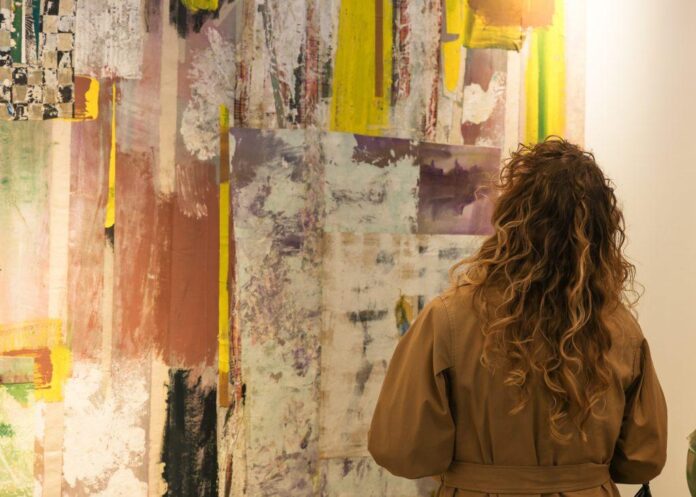There was a lemonade stand on the roof for yesterday’s preview of the New Art Dealers Alliance (NADA) fair and its youthful entrepreneurs were hustling the sour stuff in customized ‘I Heart NY’ cups. It was the Children’s Museum of the Arts’s third such fundraiser, and alongside refreshments there was art for sale too: a drawing of a dog in a field (labeled “dog”), an abstract collage of felt and colored paper, and a sculpture of a lemon-faced figure.
After meandering through four floors of tightly packed booths, the seems in keeping with the back-to-fundamentals vibe of the fair. Lest we forget, children are instinctive artists, the organization’s Genevieve Martin said, and both Rothko and Picasso were avid collectors of children’s work.
Nearby on the roof, there’s a mesmeric video work by Morehshin Allahyari, a composite of A.I.-generated images that counter the gendered gaze of 18th-century Persian portraiture. It stands out as a genuinely compelling use of A.I. in art, but also as something of an outlier at NADA.

Morehshin Allahyari, (2022). Photo: courtesy Management.
“I consider it urgent,” said Anton Svyatsky, founder of the gallery Management, which is showing the work. “I like to take risks.” Svyatsky is one of few doing so here, at least in a digital direction. Recent years may have seen an uneasy dance between Web3 evangelists and tactile purists, but the latter camp, for now is back on top.
If people reach for comfort in troubling times, the succor frequently offered across the 88 exhibitors showing at the fair from May 19 to 21 is painting, oftentimes of domestic spaces. There are a lot of paintings of beds, bedrooms, and kitchen tables, perhaps the result of some pandemic hangover.
One example is Aaron Maier-Carretero. His painting series “A Lobster Named Dinner”—so named because, well, he had a pet lobster in childhood and it was called Dinner—captures his home and reworks family interiors from photos. Maier-Carretero, represented by Luis De Jesus Los Angeles, believes art world trends come and go in sudden surges.

Aaron Maier Carretero, (2023). Image: courtesy artist and Luis De Jesus Los Angeles.
“We had a wave of NFTs, but it swung back to formalism,” he said. During 2020’s peak NFT days, he turned down numerous propositions that arrived via Instagram to mint work. “I like the dust, the paint, the glue,” he said. “Painting is something I can lean on, these spaces are available to me.”
Few domestic objects have become more familiar in the work-from-home era than houseplants. David Kennedy Cutler’s photo transfers onto canvas at Halsey McKay Gallery, ones he calls inkjet frescos, seem alive. He layers plants on top of one another with tendrils that grow out of canvases and roots that crack flattened terracotta pots. You might be tempted to water them, but there’s no need, they’re vibrant and healthy.

David Kennedy (2023). Photo: courtesy Halsey McKay Gallery.
The works pair well with those by Filipino-American weaver Behn Alan, presented by the gallery Ontopo. Alan is currently on a Fulbright studying indigenous Filipino weaving techniques. The artist’s works tie together bamboo leaves, electrical cord, rattan, plastic construction fencing, and much more—a blending of synthetic and natural materials commonly found in household objects.
“It’s like a blowing up of the minimal,” gallery director Jon Santos said. “They maintain shape really well, if you don’t touch them.” Oh, but you’ll want to.

Behn Alan 1 (2021). Photo: courtesy Ontopo.
Meanwhile, The Hole gallery recreates the home altogether with a log cabin fitted with a tartan carpet. Inside are airbrushed faux-hunting scenes by Matt Belk, a remote Oregon-based artist who the gallery discovered on Instagram.
Director Ray Bulman sees Belk’s popularity as part of a broader de-digitalization. “Everyone was preaching that [digital] gospel for 18 months, but it’s stopped,” Bulman said. “It used to have cache, but now, NFT is a code word for bad.”
Belk has been a hit both in New York and in Paris, Bulman said, and it’s easy to see why: the works of shaggy wolves and dumb-eyed dogs prancing through colorful wilds are a playful pastiche of the outside world.

Paa Joe, , , (2023). Photo: Superhouse/Luis Corzo.
Speaking of animals loping through their natural habit, one pair of works that consistently drew the attention of New Yorkers was “Subway Rat” and “NYC Trashcan” by sculptor Paa Joe at Superhouse. The Ghanaian’s practice emerges from the tradition of carving figurative coffins—a fish-shaped casket for a fisherman or a carrot for a farmer—and inside both enamel works Joe has created a space to place ashes—or desperately scribbled prayers.
With the city poised to introduce new trashcan regulations in its unending war with rodents, the timing of Joe’s work at NADA couldn’t be better.

























